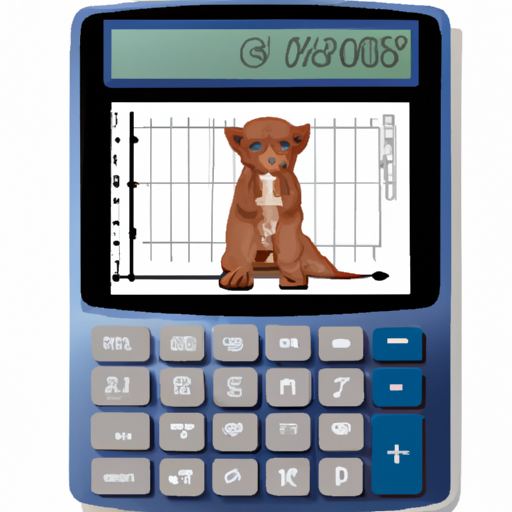Imagine being able to predict the future, or at least one aspect of it – how big your puppy will get. Sounds like a magic crystal ball, doesn’t it? Well, this is where science steps in. Welcome to the world of puppy growth estimation tools! These calculators use breed characteristics and current weight to give you a glimpse into your fur baby’s future size.
But how does this tool work exactly? What inputs are needed for accurate estimation? And how can you use these predictions for future planning? Don’t worry; we’re here to help you make sense of it all.
It’s essential that we monitor our puppies’ weight regularly as responsible pet parents, because their health depends on us understanding their needs and growth patterns. So join us on this enlightening journey as we uncover the fascinating science behind predicting your puppy’s full grown size with precision and accuracy.
Understanding the Growth Estimation Tool
Let’s dive into the fascinating world of our puppy growth estimator tool and see how it can predict just how big your furry friend will get. This intuitive tool uses key factors like breed, age, and current weight to calculate an estimation of your pup’s full-grown size. It’s based on scientific research that observes patterns in canine development.
Now, remember, this tool isn’t a magic crystal ball—it provides an estimate based on averages. Each dog’s growth can vary due to genetics, nutrition, environment, and overall health. The calculator simply gives you a ballpark figure to help you prepare for what lies ahead—whether that means buying a bigger bed or planning for more food!
In serving our pets well, knowledge is indeed power.
Inputs Required for Accurate Estimation
To unlock the mystery of your adorable furball’s future size, you’ll need to provide some specific info, like its current age, weight and breed. These inputs are integral for an accurate estimation as different breeds grow at different rates and reach various adult sizes.
Consider this table as a guide:
| Information Needed | Why It’s Important | How To Obtain |
|---|---|---|
| Current Age | Different stages of growth mean varying rates of development. | Ask your breeder or vet if unsure. |
| Current Weight | This gives a baseline from which future growth can be estimated. | Use a household or pet-specific scale. |
| Breed Type | Some breeds are naturally larger or smaller than others. Differences in breed can greatly affect final size. | Check with breeder, adoption agency, or use DNA testing for mixed breeds. |
Remember to always consult professionals when in doubt about your puppy’s health and growth.
Estimating Size Based on Breed
Knowing your pup’s breed can offer vital clues about their eventual size. Each dog breed has a general weight and height range, providing a ballpark figure for your puppy’s future stature. For instance, small breeds like Chihuahuas typically don’t exceed 5 pounds, while larger breeds like Great Danes can weigh up to 200 pounds.
However, it’s important to remember that these are averages and individual dogs may vary. Factors such as genetics and the size of the dog’s parents also play a significant role in determining how big your puppy will get.
Using a combination of breed information, parental size, and current growth rate can provide you with the best estimation for your pup’s eventual size. Always consult with a veterinarian or pet professional for more accurate assessments.
Future Planning Based on Growth Projections
Have you ever wondered how your tiny furball’s growth projections could influence your future plans? A puppy size calculator can be a crucial tool when making decisions about the future.
-
Living Arrangements: If your puppy is projected to grow into a large dog, you might need to consider moving to a house with more space or at least an ample backyard.
-
Budgeting: Larger dogs often require more food and possibly higher vet bills, which could affect your budget.
-
Travel Plans: Some airlines have restrictions on the size of dogs allowed in cabins. Knowing your pup’s expected size can help plan trips accordingly.
-
Activity Levels: Bigger breeds typically need more exercise, so you may need to adjust your schedule.
By considering these factors based on growth projections, you can ensure that both you and your furry friend will be content and well-prepared for the years ahead.
Importance of Regular Weight Monitoring
Regularly monitoring your dog’s weight isn’t just about maintaining a healthy size; it’s also an essential part of assessing their overall health and detecting potential issues early on. Weight fluctuations can be indicative of numerous health conditions, including diabetes, heart disease, or digestive disorders.
Just as in humans, obesity in dogs can lead to a variety of serious health problems. By keeping tabs on your pup’s weight and growth using a puppy growth calculator, you’ll help ensure they’re developing properly. A sudden halt in growth or drastic weight gain might signal the need for dietary adjustments or vet intervention.
Regular check-ins with your veterinarian are crucial in this process too. Remember, your commitment to their well-being is vital for their long-term health and happiness.
Frequently Asked Questions
What factors other than breed can affect the size of a fully grown dog?
“Your pup’s final size isn’t just in the genes! Nutrition, spaying/neutering, and exercise can also play a colossal role. Proper diet and activity levels promote healthy growth while early neutering may affect their size.”
Can neutering or spaying affect the final size of my puppy?
Yes, neutering or spaying can potentially affect your puppy’s final size. These procedures can delay the closure of growth plates in long bones, which may result in a slightly taller dog than if left intact.
Is it possible for a puppy to exceed the estimated size given by the calculator?
Just like humans, puppies can throw curveballs. Yes, it’s possible for your puppy to grow larger than the estimated size from the calculator. This can be influenced by factors like nutrition, health conditions or genetic variations.
How accurate are puppy size calculators compared to the estimations provided by a veterinarian?
Puppy size calculators can provide a general estimate, but they’re not as accurate as a vet’s estimation. Vets consider breed, parent sizes, diet and health factors, making their predictions more comprehensive and precise.
Does the diet and exercise of my puppy affect their eventual size?
“You are what you eat” holds true for puppies too. Their diet and exercise significantly affect their size, health, and growth rate. Balanced nutrition promotes normal growth while excessive feeding may lead to obesity.
Conclusion
In closing, remember that predicting your puppy’s size isn’t rocket science. You’ll get a ballpark figure using our growth estimation tool, with the right inputs and breed info. However, don’t carve these numbers into stone tablets! Regular weight monitoring is crucial for health reasons too. So, keep tracking their growth and adjust plans accordingly to ensure your little furball’s golden years are truly golden!



